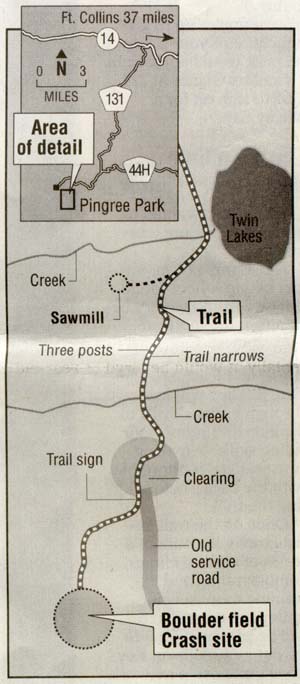Fort Collins Coloradoan, July 23, 2000

The prop shaft on the rusted engine points north--the direction from which the B-17 was flying in October.
Resting further down the steep hill is a shiny piece of mangled fuselage, probably a piece of the tail some of the hikers guessed. Scattered throughout the boulder field are the disintegrated remains of the giant bomber.
Eight men died just below timberline when the B-17 crashed into Stormy Peaks on October 18, 1943. The night training mission, which originated in Rapid City, S.D., ended in a fiery crash when the plane failed to clear the l2,148 foot mountain peak.
Most of the plane's remains are unrecognizable now, nearly 57 years after the crash. But the four giant engines remain as a memorial to the eight airmen who died that night.
And the crash site, which sits at 11,OOO feet along a trail in Pingree Park, is a popular destination for those able to find it.
Earlier this month, I joined a group of nearly 40 other hikers organized by the Rocky Mountain Recreation Company and we set out to find the boulder field and crash site. We were led by Lisa Coverstone, a teacher from Illinois who was spending a part of her summer guiding hikes.
"I like hiking and I like history," Lisa said as we headed up the trail. "This is the perfect way to enjoy both."
Lisa had already taken care of most of the hard work-- She'd spent a few days hiking the trails, trying to find the elusive remains of the B-17.
"I looked three times before I could find it," she said. "But once you do find it, it's no problem. You just have to know when to turn."
We started up the Stormy Peaks Trail at 9 a.m., winding our way up a moderately challenging trail as Lisa recited the history of the crash. She told us about the stormy night that obscured the peaks, making it difficult for the eight airmen to navigate.
And she told us the names of the men who died -- Richard M. Creamer of Ohio; Joseph R. Arnold of California; Warren M. Dean of Seattle, Andrew H. Christensen of Wisconsin; William N. Cook of Texas; Robert J. Hopkins of New York, Carl E. Hamre of Iowa; and Philip Doddridge of Colorado.
The oldest person who died in the crash was Joseph R. Arnold. He was 25.
Our large group moved slowly up the trail resting occasionally to listen to more history of the crash site. We made our way around Twin Lakes Reservoir before we hit the challenging portion of the hike.
As we entered the wilderness area, the trail became increasingly steep and loose rocks made portions of the hill unpredictable. While challenging, the entire group -- from the young children to seniors -- managed to conquer the hill.
We weren't far from the site, Lisa told us during one of our many water breaks.
"Just another few minutes," she'd say.
At that point, the younger children worked their way to the front of the pack wanting to be the first to spot the wreckage. Three hours into our hike, the trail covered by trees most of the way, opened into the giant boulder field. The first noticeable piece of wreckage is one of the four giant radial engines resting south of the trail. To the north is a stunning view of Wyoming.
We spent an hour exploring the wreckage, maneuvering carefully over the rocks. The steep hill, loose stones and rusted shards of metal made a dangerous combination. So we stepped cautiously, searching for all four engines. They're all there, but you'll have to look around to find them.
And don't let the wreckage distract you from the wonderful view to the north.
From the Pingree Park campus, follow the Stormy Peaks trail to the Twin Lakes turnoff. Once at Twin Lakes follow the trail/road to the right around the west end of the reservoir. Continue along the trail/road going right. Veer left at a fork. As the trail narrows, pass three posts and climb a steep hill entering the wilderness area. Follow a trail along a ditch, then through a clearing. Continue on the trail to the boulder field where the remains of the plane can be seen. John Herbst, one of the first hikers to find the remains, will give a presentation about the crash site at 8 p.m. Aug. 5 at Jack's Gulch campsite. Information: 493-3613.


Preserving the history of Fort Collins, Colorado & the Cache la Poudre region